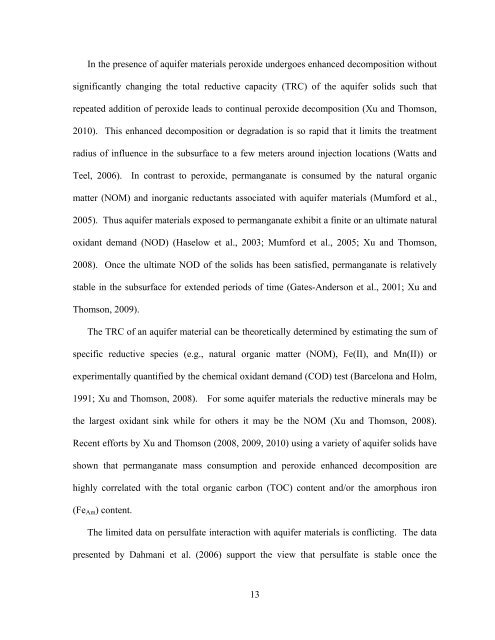Time (days) - UWSpace - University of Waterloo
Time (days) - UWSpace - University of Waterloo
Time (days) - UWSpace - University of Waterloo
You also want an ePaper? Increase the reach of your titles
YUMPU automatically turns print PDFs into web optimized ePapers that Google loves.
In the presence <strong>of</strong> aquifer materials peroxide undergoes enhanced decomposition without<br />
significantly changing the total reductive capacity (TRC) <strong>of</strong> the aquifer solids such that<br />
repeated addition <strong>of</strong> peroxide leads to continual peroxide decomposition (Xu and Thomson,<br />
2010). This enhanced decomposition or degradation is so rapid that it limits the treatment<br />
radius <strong>of</strong> influence in the subsurface to a few meters around injection locations (Watts and<br />
Teel, 2006). In contrast to peroxide, permanganate is consumed by the natural organic<br />
matter (NOM) and inorganic reductants associated with aquifer materials (Mumford et al.,<br />
2005). Thus aquifer materials exposed to permanganate exhibit a finite or an ultimate natural<br />
oxidant demand (NOD) (Haselow et al., 2003; Mumford et al., 2005; Xu and Thomson,<br />
2008). Once the ultimate NOD <strong>of</strong> the solids has been satisfied, permanganate is relatively<br />
stable in the subsurface for extended periods <strong>of</strong> time (Gates-Anderson et al., 2001; Xu and<br />
Thomson, 2009).<br />
The TRC <strong>of</strong> an aquifer material can be theoretically determined by estimating the sum <strong>of</strong><br />
specific reductive species (e.g., natural organic matter (NOM), Fe(II), and Mn(II)) or<br />
experimentally quantified by the chemical oxidant demand (COD) test (Barcelona and Holm,<br />
1991; Xu and Thomson, 2008). For some aquifer materials the reductive minerals may be<br />
the largest oxidant sink while for others it may be the NOM (Xu and Thomson, 2008).<br />
Recent efforts by Xu and Thomson (2008, 2009, 2010) using a variety <strong>of</strong> aquifer solids have<br />
shown that permanganate mass consumption and peroxide enhanced decomposition are<br />
highly correlated with the total organic carbon (TOC) content and/or the amorphous iron<br />
(FeAm) content.<br />
The limited data on persulfate interaction with aquifer materials is conflicting. The data<br />
presented by Dahmani et al. (2006) support the view that persulfate is stable once the<br />
13

















